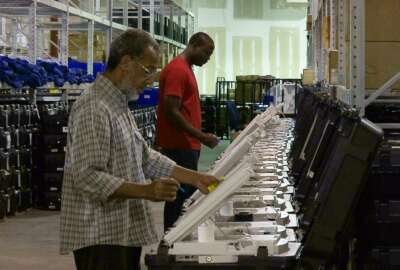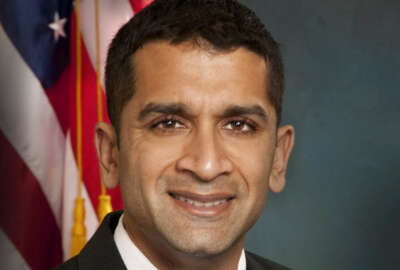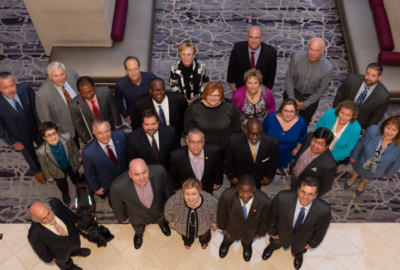
Commission calls for review of election security standards
Election Assistance Commission has called for a review of the the latest proposed standards by its board of advisors, and by the public.
Best listening experience is on Chrome, Firefox or Safari. Subscribe to Federal Drive’s daily audio interviews on Apple Podcasts or PodcastOne.
Elections in the United States are mainly the purview of state, counties and cities. But the Election Assistance Commission maintains what are known as Voluntary Voting System Guidelines. They’re aimed at ensuring security of elections. Now the commission has called for a review of the the latest proposed standards by its board of advisers, and by the public. For more of what’s going on, Federal Drive with Tom Temin spoke to the Election Assistance Commission chairman, Ben Hovland.
Interview transcript:
Tom Temin: Mr Hovland, Good to have you on.
Ben Hovland: Thanks Tom. It’s great to be here.
Tom Temin: And just review briefly the mission of the EAC because I think it may be even less understood than the FEC.
Ben Hovland: Absolutely. Well we are a small agency, but the U. S Election Assistance Commission helps election officials improve the administration of elections and helps Americans participate in the voting process. We were created with the Help America Vote Act of 2002 which many of your listeners may remember was passed after the Florida 2000 election. And so what we really do is work on, were largely non regulatory, but we work on best practices and sharing best practices around election administration across the country so that everyone’s election administration can improve or benefit from some of the best practices that jurisdictions they’re doing around the country.
Tom Temin: And before we get to the new standards, we should probably talk about the havoc that the coronavirus has wrecked on elections, I guess it all levels. Elections for federal office and local and state and everything else. And you’re helping there too.
Ben Hovland: Absolutely. Yeah, that is front and center in everyone’s mind right now. We’re looking at what we can do. Election officials around the country are facing very difficult choices right now and what we’re trying to do as the national clearinghouse on election administration information. We’re trying to collect what we can, working with federal partners like the CDC and CISA and the Postal Service to collect information that we can put those in a one stop shop for election officials. We’ve also been recording some video calls with election officials. You know, there’s a lot of talk right now about increasing vote by mail, and so, for example, we’ve done about three of them now. But the first one was we got the secretary of State of Washington, Kim Wyman, the registrar of voters of Orange County, California, and the county clerk auditor of Weber County, Utah, Ricky Hatch. And all three of these election officials have gone from a traditional polling place environment to a mail driven process. And so what we did was recorded a video where they shared sort of the pitfalls and lessons learned of having transition there so that election officials around the country who have not had as much mail in their voting process before, can learn those lessons and hopefully avoid some of those pitfalls going board.
Tom Temin: And just out of curiosity, what has the role been of the Postal Service? Do they give special rates for election ballots and that kind of thing?
Ben Hovland: There’s not free postage, but there’s definitely special treatment of election mail. The post office has got actually a whole division or they’ve got a group of folks that are dedicated to election mail that do a great job, and certainly we’ve been working with them. Actually, our second video had a representative of the post office on. And we’ve been working since elections were designated as critical infrastructure in January of 2017. But we’ve been working with our partners at CISA and with the other partners in the depending on how familiar some of your listeners are with critical infrastructure within a critical infrastructure designation, you have what’s called the Government Coordinating Council and a Sector Coordinating Council. The Government Coordinating Council being what it sounds like and the Sector Coordinating Council being private industry that is impacted by the area. But on the Government Coordinating Council side that brings together federal partners, state and local election officials on, we’ve done a number of calls through that entity with the post office with CDC. Talking about these issues, giving election officials a chance to hear firsthand information, ask questions as they relate to them. You know, things like, how do we make polling places more safe? What steps can we take? And so you know, those have provided a lot of very valuable information, and, you know, we continue to work toward those and monitor the situation, to see if they’re relevant updates that we need to push out. But it’s been a very good partnership.
Tom Temin: And I guess mail balloting brings security challenges of its own because of how many hands through which the ballots are handed, the chain of events until they’re actually counted.
Ben Hovland: Yeah, so I mean, any time you’re looking at, obviously the world that’s focused on the security of elections a lot in the last few years, election officials have always been conscious of this. But depending on what method of voting you’re using, what method of how you allow the voters to contact with your office? You know, these all create risk vectors. And so things like online voter registration have been a great good government customer service development. It saves local election officials a lot of money. It provides registration in a way that voters want to be able to do online. But that creates a risk factor, so you work to mitigate that you put protections in place in any process in elections is similar.
Tom Temin: And let’s talk about then the Voluntary Voting System Guidelines 2.0. What are they? And first what’s 1.0, and tell us the process of getting comments on 2.0
Ben Hovland: Absolutely. So the Voluntary Voting System Guidelines are one of the critical parts of the Election Systems Commissions mission and what they essentially are are the standards, in a non technical sense, but they’re the standards that voting equipment is built to. And so the VVSG 1.0 were passed several years ago. And that is what most voting machines that Americans would interact with that they see have been tested to VVSG 1.0, in one way or another, the VVSG 2.0 is really an effort to update these guidelines to incorporate some of the technological advances that happened in the last several years. An ability to make voting equipment that is more user friendly, that is, you know, has new best practices as far as usability, accessibility and, of course, security. And so The Help America Vote Act lays out the process for how that proceeds. And as you mentioned earlier, we are in the process of updating those guidelines. We have an advisory board called the Technical Guidelines Development Committee, and that is led by the National Institute of Standards and Technology, or NIST. And they helped develop the requirements that we’re talking about now. And then they recommended those to the EAC. We then pass that on to a as, you mentioned public comment and to our other advisory boards for review. And so that’s the process we’re in right now. We actually did an initial public meeting on them via Zoom call the other day. That was the first for the agency to do a public hearing via Zoom. But it was. There were a few hiccups just getting used to the technology, I think everyone is right now. And for the most part it was a success.
Tom Temin: And in developing the VVSG 2.0, the Voting Voluntary Voting System guidelines doesn’t take into account a growing, I guess, diversity of technologies used in voting. I mean, where I live for 29 years or so, I think there’s three or four different systems I’ve encountered in voting, and some of them are some are still fairly basic electro mechanical systems. You punch a hole or your touch of this area, even mark a ballot, and it’s used, you know, character recognition to count. So there’s a quite a diversity that this standard has to cover, isn’t there?
Ben Hovland: Yes, and so you know it does allow for a lot of variation. But what it ensures essentially is that any system, no matter how it’s configured, meets this standard that ensures a usable, accessible and secure election for voters. And so, you know, it’s really – it hasn’t been a quick process, but it’s an important one. The VVSG 2.0 is not about the 2020 election, but really it’s about working on, I think, about election administration as the infrastructure of our democracy. And we have to keep pushing on this set of voluntary voting system guidelines so that the manufacturers can build new equipment to these better standards. And then the state and local jurisdictions will then obviously eventually purchase those and they’ll be in the polling places down the road. But if we aren’t working on those now, then you aren’t able to get them in polling places in the future. And so it’s really an ongoing process, and that’s part of why I sort of analogized it to infrastructure. You know, you have to have that ongoing work and investment. You got to fill potholes. We continue to do our work and, you know, hope to find success.
Tom Temin: And comments are open till when?
Ben Hovland: June 22
Tom Temin: All right, well, maybe we’ll be out and about by then. Ben Hovland is chairman of the Election Assistance Commission. Thanks so much for joining me.
Ben Hovland: Thank you.
Copyright © 2025 Federal News Network. All rights reserved. This website is not intended for users located within the European Economic Area.
Tom Temin is host of the Federal Drive and has been providing insight on federal technology and management issues for more than 30 years.
Follow @tteminWFED
Related Stories





